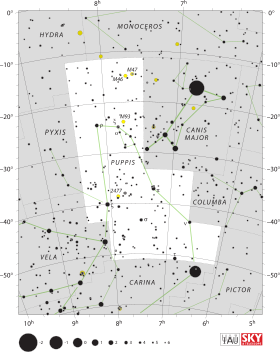NGC 2567
| NGC 2567 | |
 L'amas ouvert NGC 2567 | |
| Données d’observation (Époque J2000.0) | |
|---|---|
| Constellation | Poupe[1] |
| Ascension droite (α) | 08h 18m 35,2s[2] |
| Déclinaison (δ) | −30° 38′ 08″ [2] |
| Magnitude apparente (V) | 7,4[3] |
| Dimensions apparentes (V) | 11′[3] |
Localisation dans la constellation : Poupe | |
| Astrométrie | |
| Distance | environ 1 667 pc (∼5 440 al) [4] |
| Caractéristiques physiques | |
| Type d'objet | Amas ouvert |
| Classe | III2m[3] |
| Galaxie hôte | Voie lactée |
| Âge | 294 M a [4] |
| Découverte | |
| Découvreur(s) | William Herschel[1] |
| Date | [1] |
| Désignation(s) | OCL 709 ESO 431-SC3[3] |
| Liste des amas ouverts | |
| modifier |
|
NGC 2567 est un amas ouvert[1],[2],[4] situé dans la constellation de la Poupe. Il a été découvert par l'astronome germano-britannique William Herschel en 1793.
NGC 2567 est à environ 1 667 pc (∼5 440 al) du système solaire et les dernières estimations donnent un âge de 294 millions d'années. La taille apparente de l'amas est de 11 minutes d'arc, ce qui, compte tenu de la distance, donne une taille réelle maximale d'environ 17 années-lumière.
Selon la classification des amas ouverts de Robert Trumpler, cet amas renferme entre 50 et 100 étoiles (lettre m) dont la concentration est moyenne (III) et dont les magnitudes se répartissent sur un intervalle moyen (le chiffre 2).
Notes et références
[modifier | modifier le code]- (en) Courtney Seligman, « Celestial Atlas Table of Contents, NGC 2567 » (consulté le ).
- (en) « Results for object NGC 2567 », NASA/IPAC Extragalactic Database (consulté le )
- « Les données de «Revised NGC and IC Catalog by Wolfgang Steinicke», NGC 2500 à 2599 », sur astrovalleyfield.ca (consulté le )
- (en) « WEBDA page for open cluster NGC 2567, A site Devoted to Stellar Clusters in the Galaxy and the Magellanic Clouds » (consulté le )
Voir aussi
[modifier | modifier le code]Articles connexes
[modifier | modifier le code]Liens externes
[modifier | modifier le code]- (en) NGC 2567 sur la base de données NASA/IPAC Extragalactic Database
- (en) NGC 2567 sur la base de données Simbad du Centre de données astronomiques de Strasbourg.
- (en) NGC 2567 sur la base de données LEDA
- NGC 2567 sur le site de SEDS
- (en) NGC 2567 sur WikiSky: DSS2, SDSS, GALEX, IRAS, Hydrogène α, Rayon-X, Photo, Sky Map, Articles et images
- (en) NGC 2567 sur le site du professeur C. Seligman
Text is available under the CC BY-SA 4.0 license; additional terms may apply.
Images, videos and audio are available under their respective licenses.

